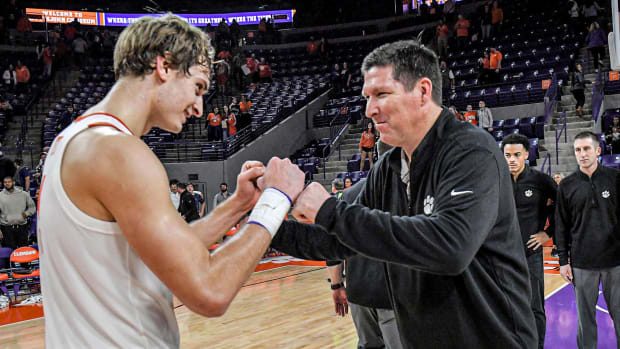The first mention I can find of Clemson’s Brad Brownell being on the hot seat came in September 2013, in an article by Athlon Sports that placed him among the 15 coaches in need of strong years to keep their jobs. His name kept popping up on those lists until a strong finish to that season, ending the year 10–8 in the ACC and advancing to the NIT semifinals.
Since then, Brownell’s name has popped up on hot seat lists every few years. The heat was on entering 2017–18 after a 17–16 season and the graduation of star Jaron Blossomgame, but Brownell’s Tigers put together a remarkable 25-win campaign and went to the Sweet 16, earning him a six-year extension in the process. Pressure was somewhat growing heading into ’20–21, but Brownell took the Tigers dancing again. And now, after his name was included on virtually every hot seat list this preseason, Clemson sits 7–0 in the ACC, alone atop the conference and in position for an NCAA tournament berth.

Ken Ruinard/USA TODAY Network
Picked 11th in the league’s preseason poll, the Tigers are among the sport’s biggest overachievers this season. Brownell appears to have yet again fanned the flames of his hot seat. And he’s not alone: Several of his counterparts projected to be sweating out their job security have put together bounce-back seasons so far, potentially changing their fates and throwing a wrench in the coaching carousel this spring.
In the ACC, the three teams (including Clemson) overachieving most came in with significant preseason coaching questions. Despite his contract running through 2027, this felt like a make-or-break year for Jeff Capel at Pittsburgh after racking up 21 losses last season, but the Panthers rebuilt quickly in the transfer portal and are now 5–2 in the ACC. NC State finished last in the ACC last season to ratchet up pressure on Kevin Keatts, but the Wolfpack are now on the cusp of the AP top 25 and in contention for an NCAA tournament berth.
Another well-timed overachiever: Bobby Hurley at Arizona State. Things had trended down in Tempe after consecutive NCAA tournament berths in 2018 and ’19, with consecutive sub-.500 campaigns that spurred questions around his job security. But halfway through January, Hurley’s rebuilt roster featuring four incoming transfer starters has the Sun Devils second in the Pac-12 and 15–3 overall. A huge week with home dates against UCLA and USC looms, but even just a split would leave ASU in a terrific position to go dancing.
And in the Big Ten, the heat was on Chris Collins at Northwestern after missing the postseason in five straight seasons. A redesigned defense and growth from guard Chase Audige has helped the Wildcats to road wins at Indiana and Michigan State and an early 3–3 mark in the Big Ten. We’re a long way from Selection Sunday still, but the Wildcats are at least in the conversation early and will have plenty of opportunities for quality wins in Big Ten play.
There isn’t necessarily a common thread in these turnarounds (other than maybe Duke ties, in the case of Collins, Capel and Hurley). Veteran talent has never been more immediately accessible than in today’s college basketball, and the turnarounds at Pitt and Arizona State can largely be credited to savvy roster moves. Across the two teams, all 10 starters are transfers (nine from Division I, one from juco), and eight of them are newcomers this season. But at Clemson and Northwestern, the surprising seasons are far more attributed to internal growth than new faces. Both coaches largely skipped out on the portal this offseason, each adding one rotation player (Brevin Galloway at Clemson, Tydus Verhoeven at Northwestern).
Perhaps a clearer throughline: The gap in talent across the high-major landscape isn’t very large. There are a few true bottom-feeders and a few legitimately elite teams, and then a glut of teams in the middle whose success will be determined by chemistry and fit more than raw talent. The difference between being No. 25 nationally and No. 75 or between No. 50 and No. 100 is far more marginal than we tend to realize.
For instance, Washington went 11–9 in the Pac-12 last year. Arizona State went 10–10. They finished 13 spots apart in KenPom. Each added four transfers this offseason, with classes EvanMiya’s analytics ranked as the No. 16 and No. 10 incoming ones in the country. Washington added a former top recruit in Keion Brooks Jr.; ASU added one in Frankie Collins. They each added hulking shot-blockers from the Mountain West: Braxton Meah at Washington, Warren Washington at Arizona State. Yet Arizona State is 15–3 and second in the Pac-12, 50 KenPom spots above a Washington team that is 3–5 in conference play and owns ghastly losses to Oregon State and California Baptist. The margins between a good year and a bad one tend to be rather small.
As for the impact on the carousel, this year’s surprise overachievers may shrink the amount of activity we see this cycle, and that might not be the worst thing. Traditional coach factories (think Xavier, Butler, Dayton, VCU, Murray State) don’t have conventional young, rising coaches, and the market for coaches (particularly in the South) is somewhat depleted after six changes made in the SEC last spring. There aren’t necessarily tons of attractive candidates out there for this to be a cycle with major turnover.
Unforeseen moves always happen: No one saw Jay Wright’s retirement last year coming, and in this cycle we’ve already seen a massive domino fall after Texas fired Chris Beard following his arrest on felony domestic violence charges in December. A few more retirements could be on the horizon, and Georgetown’s continued ineptitude under Patrick Ewing should necessitate a change no matter how uncomfortable it may be to part with a program legend. Plus, there’s no guarantee the good vibes keep rolling for these early feel-good stories.
For now, though, cheers to Brownell and the several other coaches following his lead in showing that a hot seat can be cooled.
Other observations from the week in college basketball:
- UConn’s three road losses early in Big East play were each justifiable, but the team’s home loss to St. John’s on Sunday set off all the alarm bells. The difference for the Huskies now compared with their 14–0 start has been point guard play—the team’s preseason concern. East Carolina transfer Tristen Newton has largely vanished in conference play and did not score against the Red Storm.
- Zach Edey’s 32-point, 17-rebound performance on the road in East Lansing to carry Purdue over the finish line against Michigan State may have locked up the National Player of the Year award for the junior from Canada. No other player is making an overly strong case yet, and the Boilermakers are starting to get some separation at the top of the Big Ten.







